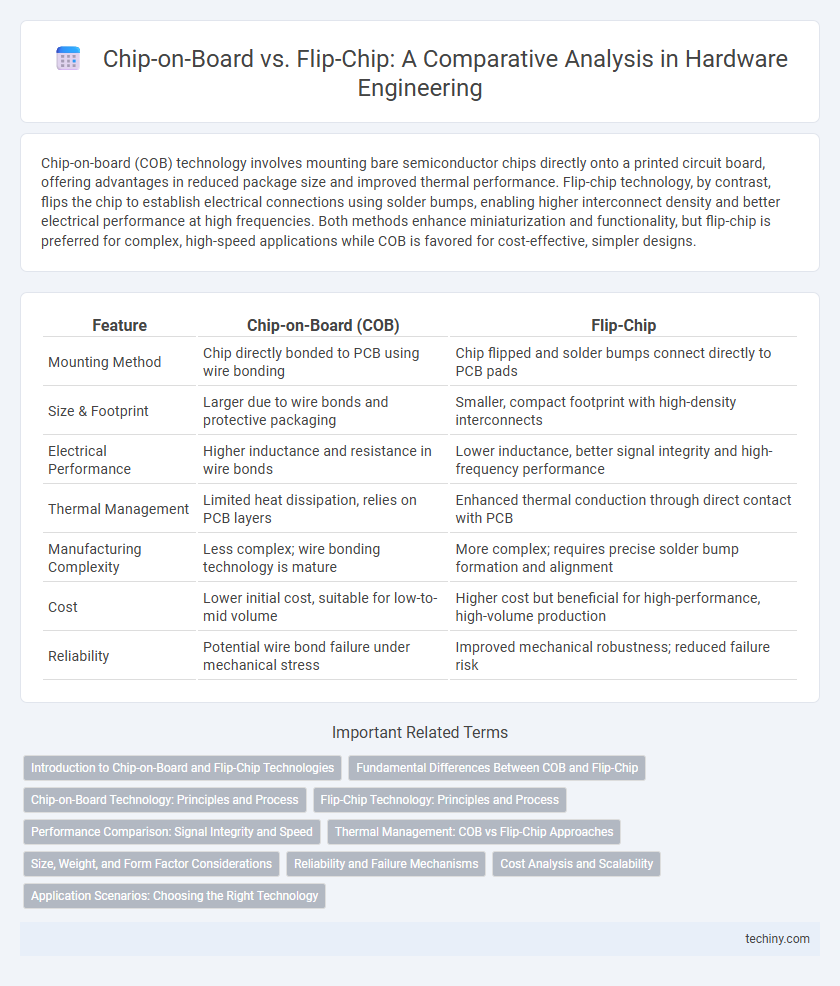Chip-on-board (COB) technology involves mounting bare semiconductor chips directly onto a printed circuit board, offering advantages in reduced package size and improved thermal performance. Flip-chip technology, by contrast, flips the chip to establish electrical connections using solder bumps, enabling higher interconnect density and better electrical performance at high frequencies. Both methods enhance miniaturization and functionality, but flip-chip is preferred for complex, high-speed applications while COB is favored for cost-effective, simpler designs.
Table of Comparison
| Feature | Chip-on-Board (COB) | Flip-Chip |
|---|---|---|
| Mounting Method | Chip directly bonded to PCB using wire bonding | Chip flipped and solder bumps connect directly to PCB pads |
| Size & Footprint | Larger due to wire bonds and protective packaging | Smaller, compact footprint with high-density interconnects |
| Electrical Performance | Higher inductance and resistance in wire bonds | Lower inductance, better signal integrity and high-frequency performance |
| Thermal Management | Limited heat dissipation, relies on PCB layers | Enhanced thermal conduction through direct contact with PCB |
| Manufacturing Complexity | Less complex; wire bonding technology is mature | More complex; requires precise solder bump formation and alignment |
| Cost | Lower initial cost, suitable for low-to-mid volume | Higher cost but beneficial for high-performance, high-volume production |
| Reliability | Potential wire bond failure under mechanical stress | Improved mechanical robustness; reduced failure risk |
Introduction to Chip-on-Board and Flip-Chip Technologies
Chip-on-Board (CoB) technology involves directly mounting integrated circuits onto a printed circuit board, allowing for compact design and enhanced electrical performance through wire bonding. Flip-Chip technology features an inverted integrated circuit flipped and connected to the substrate via solder bumps, enabling shorter interconnects and improved heat dissipation. Both techniques optimize semiconductor packaging by reducing size and enhancing electrical and thermal characteristics in hardware engineering applications.
Fundamental Differences Between COB and Flip-Chip
Chip-on-board (COB) technology involves directly mounting bare semiconductor dies onto a printed circuit board (PCB) with wire bonding for electrical interconnection, optimizing space and reducing assembly costs. Flip-chip technology flips the semiconductor die to connect solder bumps directly to the substrate pads, enabling higher interconnect density and superior electrical performance. Fundamental differences between COB and flip-chip include the method of die attachment, interconnection techniques, and resulting thermal and electrical characteristics.
Chip-on-Board Technology: Principles and Process
Chip-on-Board (COB) technology involves directly mounting semiconductor dies onto printed circuit boards, enabling high-density interconnections and reduced package size. The COB process includes die attachment, wire bonding for electrical connections, and encapsulation to protect the die while enhancing thermal dissipation. This method improves electrical performance and reliability compared to traditional packaging by minimizing parasitic inductances and capacitances inherent in larger packages.
Flip-Chip Technology: Principles and Process
Flip-chip technology enhances electronic packaging by directly mounting the semiconductor die onto the substrate with solder bumps, enabling shorter interconnects and improved electrical performance. The process involves wafer bumping, precise die alignment, reflow soldering, and underfill encapsulation to ensure mechanical stability and thermal management. Compared to traditional wire bonding, flip-chip reduces parasitic inductance and enhances signal integrity, making it ideal for high-frequency and high-density applications in hardware engineering.
Performance Comparison: Signal Integrity and Speed
Chip-on-board (COB) technology offers improved signal integrity by minimizing wire lengths and reducing parasitic inductance, which enhances overall electrical performance in high-frequency applications. Flip-chip packaging provides even lower interconnect resistance and inductance due to direct solder bump connections, enabling higher signal speed and better thermal management. While both methods improve performance, flip-chip technology generally achieves superior speed and signal integrity in advanced semiconductor devices.
Thermal Management: COB vs Flip-Chip Approaches
Chip-on-board (COB) technology typically offers better thermal dissipation through direct attachment of the semiconductor die to the substrate, enabling efficient heat spread across the circuit board. Flip-chip integration enhances thermal management by allowing heat to transfer through solder bumps directly to the heat sink, reducing thermal resistance and improving overall device reliability. Compared to COB, flip-chip design provides superior heat dissipation for high-performance processors and power electronics, minimizing hotspots and enhancing long-term thermal stability.
Size, Weight, and Form Factor Considerations
Chip-on-board (COB) technology offers a compact and lightweight solution by directly mounting bare semiconductor dies onto a printed circuit board (PCB), reducing the overall device footprint and enabling thinner form factors. Flip-chip packaging further minimizes size and weight by allowing the chip to be flipped and connected via solder bumps, enhancing electrical performance and heat dissipation while enabling higher I/O density within limited space. Both methods optimize form factor considerations for advanced hardware designs, with flip-chip generally providing superior miniaturization and thermal management compared to traditional COB techniques.
Reliability and Failure Mechanisms
Chip-on-board (COB) technology offers robust mechanical stability due to wire bonding, but it may suffer from wire fatigue and corrosion over time, impacting long-term reliability. Flip-chip assemblies provide superior electrical performance and thermal dissipation, yet are susceptible to solder joint fatigue and underfill delamination, which can lead to premature failure. Understanding these distinct failure mechanisms is crucial for optimizing reliability in advanced hardware engineering designs.
Cost Analysis and Scalability
Chip-on-board (COB) technology offers lower initial tooling costs and simpler assembly processes, making it cost-effective for small to medium production volumes. Flip-chip provides superior scalability and performance benefits by enabling higher input/output density and better thermal management, but it requires expensive bumping and underfill materials, increasing upfront investment. Cost analysis reveals COB is advantageous for limited runs, while flip-chip's scalability supports high-volume manufacturing with long-term cost efficiency.
Application Scenarios: Choosing the Right Technology
Chip-on-board (COB) technology excels in applications requiring compact, cost-effective solutions with moderate electrical performance, such as LED lighting and consumer electronics. Flip-chip offers superior electrical performance and heat dissipation, making it ideal for high-frequency devices, advanced processors, and RF applications. Selecting the right technology depends on factors like device complexity, thermal management needs, and production volume.
Chip-on-board vs Flip-chip Infographic

 techiny.com
techiny.com